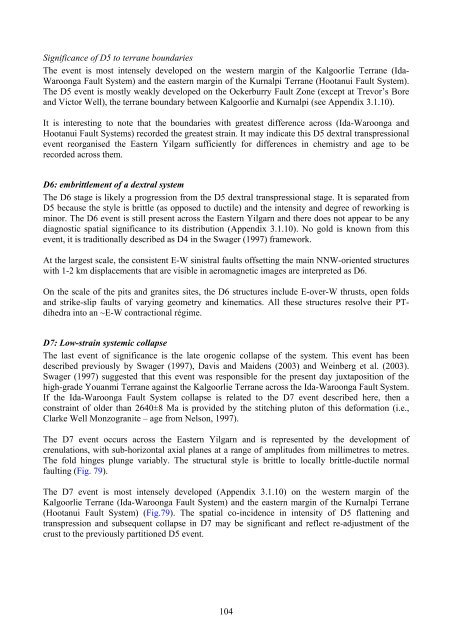92 The Lawlers Anticline and the Mt Margaret Anticline are located ...
92 The Lawlers Anticline and the Mt Margaret Anticline are located ...
92 The Lawlers Anticline and the Mt Margaret Anticline are located ...
Create successful ePaper yourself
Turn your PDF publications into a flip-book with our unique Google optimized e-Paper software.
Significance of D5 to terrane boundaries<strong>The</strong> event is most intensely developed on <strong>the</strong> western margin of <strong>the</strong> Kalgoorlie Terrane (Ida-Waroonga Fault System) <strong>and</strong> <strong>the</strong> eastern margin of <strong>the</strong> Kurnalpi Terrane (Hootanui Fault System).<strong>The</strong> D5 event is mostly weakly developed on <strong>the</strong> Ockerburry Fault Zone (except at Trevor’s Bore<strong>and</strong> Victor Well), <strong>the</strong> terrane boundary between Kalgoorlie <strong>and</strong> Kurnalpi (see Appendix 3.1.10).It is interesting to note that <strong>the</strong> boundaries with greatest difference across (Ida-Waroonga <strong>and</strong>Hootanui Fault Systems) recorded <strong>the</strong> greatest strain. It may indicate this D5 dextral transpressionalevent reorganised <strong>the</strong> Eastern Yilgarn sufficiently for differences in chemistry <strong>and</strong> age to berecorded across <strong>the</strong>m.D6: embrittlement of a dextral system<strong>The</strong> D6 stage is likely a progression from <strong>the</strong> D5 dextral transpressional stage. It is separated fromD5 because <strong>the</strong> style is brittle (as opposed to ductile) <strong>and</strong> <strong>the</strong> intensity <strong>and</strong> degree of reworking isminor. <strong>The</strong> D6 event is still present across <strong>the</strong> Eastern Yilgarn <strong>and</strong> <strong>the</strong>re does not appear to be anydiagnostic spatial significance to its distribution (Appendix 3.1.10). No gold is known from thisevent, it is traditionally described as D4 in <strong>the</strong> Swager (1997) framework.At <strong>the</strong> largest scale, <strong>the</strong> consistent E-W sinistral faults offsetting <strong>the</strong> main NNW-oriented structureswith 1-2 km displacements that <strong>are</strong> visible in aeromagnetic images <strong>are</strong> interpreted as D6.On <strong>the</strong> scale of <strong>the</strong> pits <strong>and</strong> granites sites, <strong>the</strong> D6 structures include E-over-W thrusts, open folds<strong>and</strong> strike-slip faults of varying geometry <strong>and</strong> kinematics. All <strong>the</strong>se structures resolve <strong>the</strong>ir PTdihedrainto an ~E-W contractional régime.D7: Low-strain systemic collapse<strong>The</strong> last event of significance is <strong>the</strong> late orogenic collapse of <strong>the</strong> system. This event has beendescribed previously by Swager (1997), Davis <strong>and</strong> Maidens (2003) <strong>and</strong> Weinberg et al. (2003).Swager (1997) suggested that this event was responsible for <strong>the</strong> present day juxtaposition of <strong>the</strong>high-grade Youanmi Terrane against <strong>the</strong> Kalgoorlie Terrane across <strong>the</strong> Ida-Waroonga Fault System.If <strong>the</strong> Ida-Waroonga Fault System collapse is related to <strong>the</strong> D7 event described here, <strong>the</strong>n aconstraint of older than 2640±8 Ma is provided by <strong>the</strong> stitching pluton of this deformation (i.e.,Clarke Well Monzogranite – age from Nelson, 1997).<strong>The</strong> D7 event occurs across <strong>the</strong> Eastern Yilgarn <strong>and</strong> is represented by <strong>the</strong> development ofcrenulations, with sub-horizontal axial planes at a range of amplitudes from millimetres to metres.<strong>The</strong> fold hinges plunge variably. <strong>The</strong> structural style is brittle to locally brittle-ductile normalfaulting (Fig. 79).<strong>The</strong> D7 event is most intensely developed (Appendix 3.1.10) on <strong>the</strong> western margin of <strong>the</strong>Kalgoorlie Terrane (Ida-Waroonga Fault System) <strong>and</strong> <strong>the</strong> eastern margin of <strong>the</strong> Kurnalpi Terrane(Hootanui Fault System) (Fig.79). <strong>The</strong> spatial co-incidence in intensity of D5 flattening <strong>and</strong>transpression <strong>and</strong> subsequent collapse in D7 may be significant <strong>and</strong> reflect re-adjustment of <strong>the</strong>crust to <strong>the</strong> previously partitioned D5 event.104
















